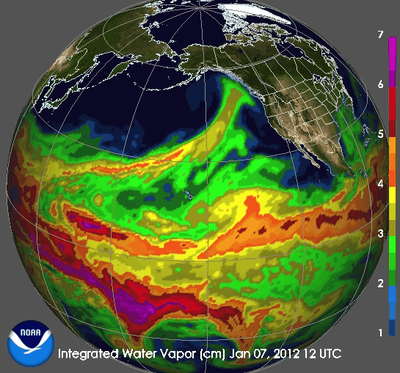By Jana Hemphill
Maybe you saw it in a recent weather forecast, a friend mentioned it while talking about a snowstorm in the mountains, or you saw the headline online: Atmospheric river to bring heavy rain, snow to Oregon. It seems that atmospheric rivers are being talked about everywhere these days. But what is an atmospheric river and how does it affect Central Oregon?
Let’s look at the definition first. Atmospheric rivers are long, relatively narrow areas in the atmosphere that carry water vapor from the tropics towards the poles. Atmospheric rivers can be more than 1,000 miles long. They are also 250-375 miles wide on average. (See what I mean by relatively narrow? This is considered narrow in the context of weather systems.) When water evaporates into the atmosphere in the tropics, it is then moved by weather systems. Atmospheric rivers flow in the lowest part of the atmosphere, generally about 1/2 mile above the ground.
Atmospheric rivers recently received a rating system in 2019. It’s a 1-5 number scale based on the quantity of water vapor. Unusual for weather events, though, the rating system is also based on whether the atmospheric river is beneficial, hazardous, or a little bit of both. The Western US depends on atmospheric rivers for our water supply. A mild atmospheric river storm can bring much-needed relief from droughts and help recharge groundwater. But a strong atmospheric river event can bring flooding and mudslides. And if temperatures are above freezing at higher elevations, atmospheric river events can cause a rain on snow event that melts snowpack more quickly, instead of increasing the snowpack.
Of course, climate change has disrupted our atmospheric river systems. It is already being shown that climate change has increased the intensity and frequency of atmospheric river storms, leading to more large-scale flooding. Warmer temperatures bring more rain on snow events. In addition, after wildfires, the large amounts of rainfall that can come with an atmospheric river event can have hazardous consequences. With vegetation burned on hillsides and ash layered on the soil, the rain can’t be absorbed and debris on the hillside is swept up by the runoff. This causes mudslides and debris flows, which have become more prevalent in places like California after their wildfire season.
As scientists learn more about atmospheric rivers, communities are able to become more resilient when a hazardous storm arrives. Currently, atmospheric river event’s timing and severity can be predicted several days in advance, so planning for extreme weather events can happen.
Atmospheric rivers are a critical part of our weather patterns in Central Oregon and throughout the Western US, even as climate change alters them. Plus, when an atmospheric river storm brings 1-3 feet of snow to the Central Cascades, we can be sure to get out and play in all that glorious snow.
Sources:
- What are Atmospheric Rivers?, NOAA
- What is an Atmospheric River?, NOAA SciJinks
- Rivers in the Sky: 6 Facts You Should Know about Atmospheric Rivers, USGS
Learn more:
- Watch our January 26th Nature Night: A Low-to-No Snow Future with Dr. Alan Rhoades and Dr. Eric Siirila-Woodburn. Register for free today!
- Rain-on-snow Events in Central Oregon
- Five Things to Know about La Niña


